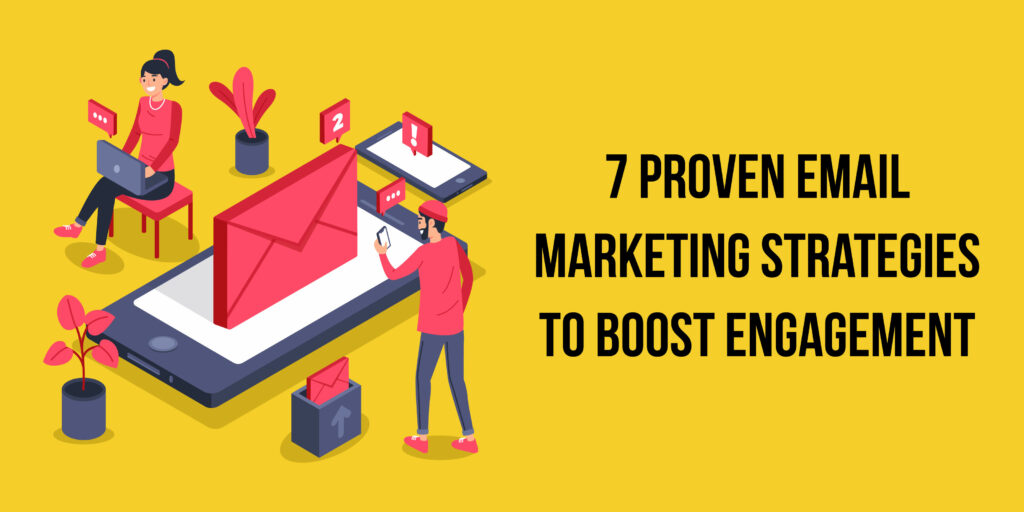
7 Proven Email Marketing Strategies to Boost Engagement
In today’s digital age, amidst the barrage of social media notifications and digital advertisements, email marketing remains a stalwart strategy for engaging with your audience. With an estimated 4 billion email users worldwide, the potential reach and impact of email marketing are unparalleled. However, standing out in crowded inboxes requires more than just sending out generic messages. To truly captivate your audience and drive meaningful engagement, you need to employ proven email marketing strategies tailored to your audience’s preferences and behaviors. In this blog, we’ll explore seven tried-and-tested email marketing strategies that are guaranteed to boost engagement and yield impressive results for your campaigns. Whether you’re a seasoned marketer or just starting out, these strategies will help you maximize the effectiveness of your email marketing efforts and nurture lasting relationships with your subscribers.
Importance of creating email marketing strategies for brands
Creating effective email marketing strategies helps brands to engage with their audience, drive sales, and build long-term relationships, ultimately contributing to their success in the digital marketplace.
Direct Communication: Email marketing provides a direct line of communication between brands and their audience. By sending personalized messages directly to subscribers’ inboxes, brands can engage with their audience on a one-on-one basis.
Cost-Effective: Compared to traditional marketing channels, email marketing is cost-effective. It has a high return on investment (ROI) because it requires minimal overhead costs to reach a large audience.
Targeted Marketing: With email marketing, brands can segment their audience based on demographics, behaviors, and preferences. This allows for highly targeted and relevant messaging, increasing the likelihood of engagement and conversions.
Increased Brand Awareness: Regularly sending emails to subscribers helps to keep the brand top-of-mind. Consistent communication through email reinforces brand identity and increases brand recall among subscribers.
Drive Traffic and Sales: Email marketing can drive traffic to the brand’s website or online store, leading to increased sales and conversions. By including links to products, promotions, or blog posts, brands can encourage subscribers to take action.
Build Customer Relationships: Email marketing allows brands to nurture relationships with their audience over time. By providing valuable content, addressing customer needs, and soliciting feedback, brands can build trust and loyalty with their subscribers.
Measurable Results: Email marketing platforms provide comprehensive analytics that allow brands to track the performance of their campaigns. Metrics such as open rates, click-through rates, and conversion rates provide valuable insights into what is working and what can be improved.
Top Effective Email Marketing Tools
Every email marketing tool has its own strengths and features, so the best choice depends on your specific needs, budget, and level of expertise.
- Mailchimp: Popular for its user-friendly interface, automation, templates, and analytics.
- Constant Contact: Easy templates, list management, social integration, good for small businesses.
- HubSpot: Comprehensive suite with email, CRM, and automation, suitable for all sizes.
- ConvertKit: Tailored for creators, and bloggers, with forms, automation, and landing pages.
- AWeber: Reliable deliverability, autoresponders, split testing, for small to medium businesses.
- GetResponse: Offers email, automation, landing pages, webinars, and CRM in one solution.
- Sendinblue: Affordable platform for email, SMS marketing, automation, and scalability.
- Drip: E-commerce focused on advanced segmentation, personalization, and automation.
Top email marketing strategies to leverage
- Know Your Audience: Before crafting messages, understand your ideal customer profile (ICP). What are their interests and pain points? Segment your email list to target specific groups with tailored content that truly speaks to them.
- Value-Driven Content: People are bombarded with emails. Make yours stand out by offering genuine value. Provide helpful tips, insightful industry trends, or exclusive content that educates and empowers your subscribers.
- Personalization Power: Personalization goes beyond just using a name. Leverage data to segment your audience and tailor content based on interests, purchase history, or website behavior. This creates a more relevant and engaging experience.
- Subject Line Mastery: The subject line is your first impression. Craft clear, concise, and intriguing subject lines that pique curiosity and entice people to open your email. Use strong verbs, keep it short, and A/B test different options to find what resonates best.
- Call to Action Clarity: Tell your audience what you want them to do next. Include a clear and compelling call to action (CTA) in every email, whether it’s visiting a landing page, making a purchase, or subscribing to a service.
- Mobile-Friendly Design: More and more people are checking emails on their phones. Ensure your emails are optimized for mobile devices with responsive design and clear, concise content.
- Automation Efficiency: Leverage email automation to streamline your campaigns and deliver targeted messages at the right time. Welcome emails, abandoned cart reminders, and post-purchase follow-ups are powerful tools for nurturing leads and boosting conversions.
- Data-Driven Optimization: Track your email marketing metrics like open rates, click-through rates, and unsubscribe rates. Analyze this data to understand what’s working and what’s not. Use these insights to continuously refine your strategies and improve your email marketing game.
Conclusion
Effective email marketing strategies are essential for engaging with audiences, driving conversions, and fostering long-term relationships with customers. By focusing on personalization, segmentation, valuable content, and consistent communication, businesses can maximize the impact of their email campaigns and achieve their marketing goals. It’s imperative to continuously analyze data, adapt to evolving trends, and refine strategies to ensure sustained success in the dynamic landscape of email marketing.
Frequently Asked Questions
What is email marketing techniques?
Email marketing techniques involve using emails to promote products, services, or content to a targeted audience.
What are the 3 main steps in email marketing?
The 3 main steps in email marketing are: building an email list, creating engaging content, and analyzing results for optimization.
What is the first rule of email marketing?
The first rule of email marketing is to obtain permission from recipients before sending them emails, ensuring compliance with regulations and building trust with subscribers.



